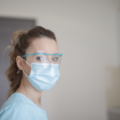Healthcare Workers Still Exposed. Experts demand action to keep healthcare workers and patients safe.
As the Aberdeen Royal Infirmary has had to close two wards to visitors as a result of COVID-19 outbreaks and with growing outbreaks of other airborne infections, a leading scientific body has issued important technical guidance to keep healthcare workers and patients safe in healthcare settings.
The British Occupational Hygiene Society, the country’s leading workplace health protection body, has issued technical guidance on how healthcare employers make decisions about the appropriate Personal Protective Equipment to protect against airborne risks.
Aside from the huge loss of life and legacy of illness among healthcare workers as a result of the COVID-19 pandemic, healthcare workers are at particular risk from exposure to airborne diseases. Many of the protections afforded to patients, such as increased ventilation, distancing and protection because of mask wearing, are not an option for healthcare workers who deliver care within arm’s length of patients.
“The compromises and confusion arising from the pandemic period have left many employers uncertain about the scientific and legal necessity to use the right PPE to protect healthcare workers. Some unfortunate messages about the poor management of PPE have made the situation worse. This guidance, which has had the input of leading experts from healthcare bodies, manufacturers, safety professionals and experts in the Health and Safety Executive, aims to clarify things,” says BOHS President Adrian Parris.
The Society points out that there is a legal obligation on employers to prevent healthcare workers themselves from getting infections where their work puts them at higher risk of exposure.
“While vaccination can work for many people to lessen the effects of infections such as COVID-19, it does not protect everyone and it does not protect completely. Nor does it prevent healthcare workers from carrying infections to vulnerable patients. The impact on other workers when people have to take time off is to be counted in mental health and fatigue,” says Professor Raymond Agius, a leading expert in occupational medicine and former BOHS President.
“We know that healthcare settings in the UK lack systematic protection for workers against the risk of airborne infections. While proper personal protection is the last line of defence, it is as important to a healthcare worker to have access to it when treating a patient affected by airborne disease, just the same as it is a driver to wear a seatbelt. Over the pandemic period, we have lost sight of that.”
The Society is concerned that an inference is circulating in senior infection prevention and control circles which incorrectly suggests that standard surgical masks (designed to stop the wearer from infecting others with droplets from their nose and mouth) offer to the wearer the same protection as respirators, which are specially designed to stop the wearer inhaling infected particles. This arises from the widespread challenges in implementing Respiratory Protective Equipment schemes in healthcare settings during the pandemic. The UK’s approach to Infection Prevention and Control has continued to be a problematic one, with a focus on controlling contact and so-called droplet-spread infections, but without any national system for tracking hospital-acquired airborne infections for healthcare workers or patients.
“COVID-19 should have been a wake-up call that we are not properly equipped to protect our healthcare infrastructure from airborne infections. We are concerned that uncertainties about management practicalities may be preventing healthcare employers from taking the legally required steps to keep their workforce at work and healthy,” says BOHS President, Adrian Parris.
The Society points out that employee absences because of airborne disease cost the NHS well in excess of a billion pounds last year in absences, overtime, agency costs and in the mental health and fatigue impact on staff left to pick up the burden. That is in addition to the human cost of hundreds of workers with lasting effects of infection, whether or not vaccinated.
“We can’t afford ignorance of the requirement to use proper Respiratory Protective Equipment to make those matters worse. That’s why all IPC, Health and Safety managers, Occupational Health professionals and employers need to read and understand this guidance and implement it. For Mpox, TB, SARS and some circumstances of MRSA infection, this is entirely in line with the IPC recommendations in England, so there should be no ambiguity,” says BOHS CEO Professor Kevin Bampton.
“However, in addition to any CQC inspectable requirements, consideration of proper RPE should be made in accordance with a risk assessment of the likelihood of infectious exposure in relation to airborne/partially airborne diseases, including COVID-19, Rubella, RSV, PVL, Meningitis, Pneumonia and Mumps. This is in order to meet the requirements of the Control of substances Hazardous to Health Regulations which create a legally enforceable duty on employers to protect their workers.”
You can read the guidance here.
You can find all the BOHS technical guidance here.




